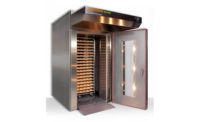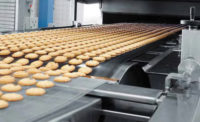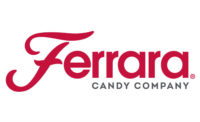Curbing oven energy usage




bakers, adopting practices to help reduce oven energy consumption can be.
Like all manufacturers, bakers and snack producers have watched their operating expenses increase year after year. The cost of ingredients, transportation, labor and other essentials continue to go up, and there’s often little food producers can do but to absorb it…and look for other areas in which to cut spending.
One area in which many manufacturers are looking to reduce their costs is energy usage. More companies are discovering that even simple actions like turning off unused lights and equipment, buying energy-efficient appliances and lighting and installing window shades can help lower energy use and costs.
Many bakers and snack producers are re-examining their manufacturing processes and equipment, especially when it comes to baking ovens, the primary contributors to their utility costs.
“Cost savings are the driver,” contends Joseph S. Zaleski Jr., president of Reading Bakery Systems, Robesonia, Pa., about the growing interest in reducing oven energy usage.
A Markel Venture company, Reading Bakery Systems designs and manufactures industrial systems for the production of crackers, pretzels, cookies and other baked snacks. According to Zaleski, the company’s ovens incorporate a number of features designed to help bakers and snack producers save on energy, including increased oven insulation, oven belts with lower mass densities, minimal oven belt exposure outside the oven chamber, downtime software for idle oven periods and stack heat exchangers to pre-heat makeup and combustion air. Reading Bakery also offers hybrid direct gas-fired (DGF) and convection ovens.
But cost isn’t the only factor influencing bakers’ and snack producers’ desire to reduce oven energy usage. Rick Rodarte, director of product management and engineering at Stewart Systems Inc., Plano, Texas, says incentives offered by power companies, municipalities and states to bakeries with energy-related ratings and garnering business from customers that require bakeries with which they contract to have energy ratings are also motivators. He cites the U.S. Green Building Council’s voluntary Leadership in Energy and Environmental Design (LEED) program and the U.S. Environmental Protection Agency’s Energy Star program as two programs that rate bakeries’ energy usage.
Stewart Systems designs and manufactures high-speed, industrial bread and bun equipment and systems. Its conveyorized ovens offer a variety of energy-saving features, including oven air circulation, advanced burner controls and insulation and enclosure materials. “We are working on new features for our ovens that reduce the amount of BTUs [British thermal units] required in the overall baking process,” says Rodarte. “We [also] are looking at alternate energy sources that could be used to bake and ways to reduce the bake time. We have significant R&D projects in all of these areas.”
Jerry Barnes, senior vice president, engineering, at Baker Thermal Solutions, Clayton, N.C., says oven energy reduction has a “domino effect. Focus on energy usage leads to greater efficiency, which has a corollary effect on improved product quality and consistency. Our energy- and exhaust-flow monitoring capabilities aim to do just that.”
Baker Thermal Solutions offers industrial bakery equipment (proofing, baking, product-handling, cooling and pan and lid systems), system solutions and aftermarket services. “[The company] has focused significant attention on features to maximize product quality and minimize energy usage,” explains Barnes. “Our Advanced Oven Process Control (OPC) provides variable-speed control of coloraider and exhaust fans to enhance baking profile control. This allows us to also employ a coloraider fan ‘sleep’ mode during production breaks.
“Further, Advanced OPC includes an automatic damper for the main exhaust, which helps remove the human element as well provide for optimal flow. Also, our eBake oven instrumentation package provides real-time monitoring of gas and electrical energy usage as well as exhaust flow parameters. This information is akin to having a tachometer on your car dashboard—you always know when the oven ‘engine’ is performing.”
To buy or not to buy?
Bakers and snack manufacturers basically can take two approaches to reduce their oven energy usage: They can buy new, energy-efficient ovens; or they can employ a variety of energy-reducing techniques to reduce existing oven energy consumption.
Those opting to invest in new ovens instead of trying to eke some energy savings out of existing equipment will want to take a close look at their operations, product lines and current and future needs to determine what kind of oven will deliver the most energy and cost savings for them. Not surprisingly, manufacturers’ opinions vary on which type of oven is best.
“The two main types of oven in the baking industry are conveyorized and tunnel-and-tray,” explains Rodarte. “Both have inherent features that lend themselves to energy savings. Conveyorized ovens are, in effect, a large box with heat being exhausted out, so they lend themselves to the heat-recovery concept well. Tunnel-and-tray ovens are sectioned into zones, and the burner controls can be set up to interact with the product in a way that closely follows the baking profile. Both types are considered efficient for different reasons, and there are many debates about which is better. It largely depends on the product mix being produced.”
According to Zaleski, “Convection ovens or zones are more efficient than direct gas-fired (DGF) as heat transfer with convection air utilizes both temperature and air velocity to deliver heat. DGF ovens heat the natural air currents in the oven and provide some low level radiation heat.”
Barnes, on the other hand, advises buyers to “be wary of claims by indirect oven manufacturers that their gas usage is much lower than a DGF. The total energy consumption must be considered and an indirect, or convection oven, typically requires large electrical fans for recirculation.”
Energy-reduction procedures
Bakers and snack manufacturers not in the market for new energy-efficient ovens can still reduce energy use on existing ovens by incorporating any of a number of things into their baking processes.
One of the most obvious ways to reduce energy use and cost is to understand where the energy actually goes. “Energy usage in a DGF tunnel oven goes into four primary areas: Heating the pan; heat lost in the exhaust; evaporation of water; and heating of the remaining water,” explains Barnes. “Only 3-5% of the oven energy is lost through the insulation or sidewalls, so be wary of claims about special interior coatings that can save you a purported 20%.”
Another seemingly obvious thing for bakers to do is to make sure the oven is “set up correctly to operate at maximum efficiency for baking their specific products,” says Rodarte.
Bakers and snack producers should also tune up their ovens. “Have the oven manufacturer conduct a process inspection to audit performance and then follow up on the recommendations,” says Barnes. “Dirty combustion air filters, mixer valves and burners; misadjusted Tri-Zone burners, igniters and modulating valves; and poorly running coloraider systems all waste energy. It’s no different than keeping your car tuned for optimal performance and maximum fuel efficiency.”
Zaleski concurs: “Clean and tune all gas burners. Air filters should be cleaned and ribbon burners pulled from the oven and rebuilt. Ribbons get clogged with soot and burners will be at least 20% less efficient. On convection gas-air ratio burners, check the burner CO and O2 levels to make sure the ratio is correct.”
Exhaust control
Zaleski recommends bakers measure the gas flow to their ovens during steady-state production and calculate the BTUs per lb. or kilowatt per kg. of gas energy required for products. “This is your benchmark,” he says.
Barnes, Rodarte and Zaleski all say bakers should control oven exhausts. “Exhaust settings need to be optimized,” explains Zaleski. “Approximately 20% of the gas energy goes to re-heating makeup air.”
Barnes adds: “Be sure that your oven exhauster is operating efficiently. Too much flow wastes valuable heat and too little can be even worse. Insufficient exhaust flow in a bread oven traps water vapor, which delays bread development, dampens burner output and leads, over time, to extensive damage to the oven interior.”
Proofer exit temperatures are also an important input of the baking process, Barnes says, explaining that low proofer exit temperatures can lead to increased bake times and more energy consumption.
Pan weight can be a factor, too, in reducing oven energy. “Heating pans to oven temperatures accounts for roughly 25% of the energy expenditure,” says Barnes. “Leading pan manufacturers have been introducing low-mass pans that required less heat to reach temperature. There is a secondary effect in that there is less heat shed into the plant from low-mass pans, helping to reduce plant energy costs.”
Zaleski offers bakers and snack producers some final oven maintenance advice: “Use an infrared camera to take a picture of your oven. This will clearly show you where the heat leaks are at. During downtime, disassemble the oven in the worst areas. Use foil and high-temperature insulation to minimize heat leaks.” And don’t forget to check oven door seals and end close-offs and replace seals as needed.
Looking for a reprint of this article?
From high-res PDFs to custom plaques, order your copy today!










